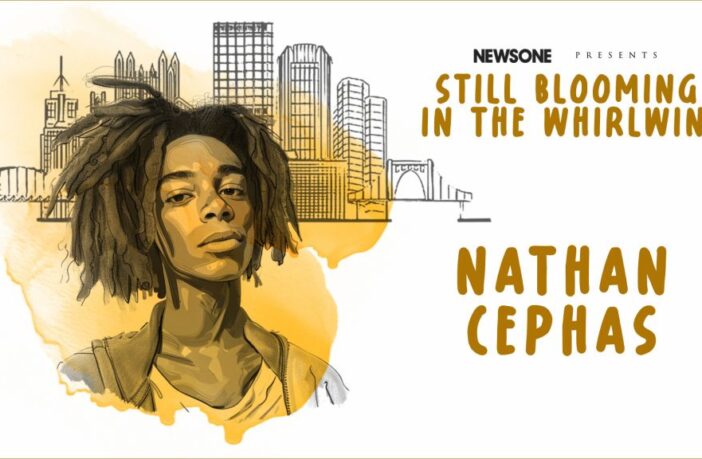Source: iOne Digital Creative Services
Musician and photographer Nathan Cephas prizes process over product. His debut album – ethereal and soulful, subtle and slinky – is an unfurling meditation, an ongoing experiment.
Cephas has found freedom by staying in the moment; across disciplines, he chooses to put himself in situations where a flow state is the only option, and any impulse to double back or second-guess is subsumed by the relentless movement of time. Cephas finds beauty in the honesty of imperfection – the “off” note that deepens the patina of a song, the wrong turn that yields a new vista – and his relationship with Pittsburgh draws deeply on what few appreciate about his city: the nature flourishing everywhere, omnipresent and unseen.
NewsOne Presents Still Blooming In The Whirlwind: Pittsburgh As A Black Cultural And Artistic Mecca
The album you’re working on sounds very process-driven: you’re only recording first takes, complete takes, no revision, no going back. How did you come to that decision, and what does it mean to you?
The majority of the songs stem from us being in the moment jamming; usually sitting on the living room floor with some type of sci-fi or Studio Ghibli film playing on the projector with the sound off. It wasn’t necessarily a sought-after decision, just where we found ourselves naturally.
Our creative foundation lies in experimentation; recording first takes and creating with no destination is really freeing – if there is a slight note missed or any “imperfections” that get captured, it just adds to the character of the track. It also helps us stay in a flow; if we find ourselves trying too hard or trying to force a recording or idea, we let it go. For us, the first expressions are usually the purest. A practice is to avoid resistance and keep it simple.
At the moment, trying to record stuff that sounds super polished and clean seems stressful and unnecessary. We enjoy the rawness and the demo-ish sound we’ve been sitting with. I think the freedom to explore is crucial when making anything, and that freedom means a lot to me.
What musical traditions do you see yourself working in – either in terms of influence, or in terms of how you want this project to be consumed, the kind of work you want it to do in the world?
There’s not a lot of desire behind what I want it to do. If anything, just to open people’s hearts, and maybe provide a sonic space for one to find solace in. To be honest the thought of making these works public is a little intimidating. However, I think once we finally start releasing, it will create its own space, and it’ll be neat to see who gravitates to it.
I’d say I shy away from tradition, but as far as influence for [how the music is released], I love the way the group SAULT operates: super reclusive, just letting the music speak for itself, while also letting their creative efforts be an offering to God. I resonate with how they move, deeply.
Your plan is to keep this album off of streaming and instead promote it through live events. What’s behind that choice?
Everything is on the internet nowadays, and it has its pros and cons, but I think as a society we’ve gotten used to everything being super accessible and ready with the snap of our fingers. It’s not natural. I was once told we’re living in the microwave generation – people want things now. I’ve always been interested in moving counter to that and providing a moment for people to slow down and get something real. Focusing on an experience, a way for someone to have a personal relationship with the art is a big intention. So as of right now, the plan is to release the main project via CD only, not for purchase – you just have to find it, or even better, it finds you. Eventually it’ll hit streaming but first, it’ll exist outside of that for a while.
In addition to being a musician, you’re also an accomplished photographer, and you’re working on a limited-edition book about Pittsburgh. Tell me about your process as a photographer; that’s obviously another discipline that relies on improvisation and attunement to the moment, balanced with a formal understanding of composition. And a lot of musicians are excellent photographers; Milt Hinton and David Byrne and Patti Smith all come to mind. Do you find that you think differently as a photographer than as a musician?
Whoa, those are all great names! I don’t think differently between the two; to me, they’re both tools or mediums for translating the same energy. I try to leave thinking behind when making art, so I can be a clear channel for that energy to flow through. In some ways I move a little differently in the pursuit of a photograph: very slow, sitting with the land. For the past four years I’ve mainly taken nature photos, and it’s been very healing. After I shoot, I tend to not look at any of the work for weeks or months; it helps create distance between the work and me and then I can view it with new eyes and see where it may fit with other photos. That’s why in the past year I’ve fallen in love with film – you can’t see anything until you get it developed.
Talk to me about capturing Pittsburgh. What does the city mean to you, and what aspects of it are you excited about portraying?
I’ve had my ups and downs with this city, but I now appreciate it more than I ever have. It’s truly a lovely place to call home. It’s usually identified with bridges, sports, and steel; I feel like nature is an underdog here. Not too long ago I was moved to do some reflecting, and I was like, “Wait a minute?! Why isn’t the greenery here in that equation?” Outside of the winter months, Pittsburgh is so lush! To have city and be able to make two turns off a main road and be fully immersed on a trail in nature is something so magical, especially thinking of the history of this town – which was known as “Smoky City” in the early to mid 1900s; I’ve seen old photos of downtown looking like Gotham due to all of the pollution caused by the big factories in the area. The book is essentially highlighting nature here in Pittsburgh, expressing gratitude, and honoring the resilience and ever-giving presence and grace of Mother Earth.
Adam Mansbach is a novelist, filmmaker (Barry), and writer whose work has appeared in The New Yorker, The New York Times Book Review, Esquire, The Washington Post and The Guardian. The Golem of Brooklyn is his latest book.
SEE ALSO:
Michael Chapman Is Keeping The Music Alive
The Joy, Pain, Love And Art Of Marvin Touré
10 photos



